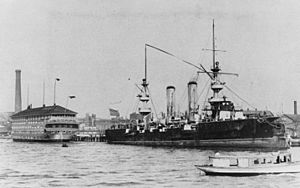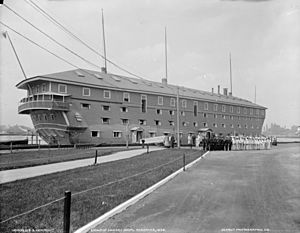USS Vermont (1848) facts for kids

Model of Vermont as designed at the U.S. Navy Museum
|
|
Quick facts for kids History |
|
|---|---|
| Name | USS Vermont |
| Namesake | Vermont |
| Ordered | 29 April 1816 |
| Builder | Boston Navy Yard |
| Laid down | September 1818 |
| Launched | 15 September 1848 |
| Commissioned | 30 January 1862 |
| Stricken | 19 December 1901 |
| Fate | Sold 17 April 1902 |
| General characteristics | |
| Class and type | North Carolina-class ship of the line |
| Tons burthen | 2,633 |
| Length | 197 ft 1.5 in (60.084 m) |
| Beam | 53 ft 6 in (16.31 m) |
| Depth of hold | 21' 6" |
| Propulsion | sail |
| Complement | 820 |
| Armament |
|
The USS Vermont (1848) was a large sailing warship built for the United States Navy. It was meant to be a powerful "ship of the line" when its construction started in 1818. However, it wasn't officially put into service until 1862. By then, the ship was too old-fashioned for battle. So, it was used as a floating warehouse for supplies and a "receiving ship" where new sailors waited for their assignments.
Contents
Building the Vermont
The Vermont was one of nine large warships that the United States Congress approved on April 29, 1816. Its construction began at the Boston Navy Yard in Boston, Massachusetts, in September 1818. The ship was mostly finished around 1825.
However, it stayed on the dry dock for many years. This was done to save space and reduce fire risks. The Vermont was finally launched into the water on September 15, 1848. Even after launching, the ship was not put into active service. It remained stored at Boston until the American Civil War started in April 1861.
Vermont During the Civil War
Joining the Blockade Squadron
When the Civil War began, the Navy needed a large ship like the Vermont. Its huge hull was perfect for storing supplies and housing new sailors. It was needed at Port Royal, South Carolina.
The Vermont was officially put into service in Boston on January 30, 1862. Commander Augustus S. Baldwin was in charge. The ship was ordered to sail to Port Royal on February 17, 1862. There, it would join Rear Admiral Samuel Francis Du Pont's South Atlantic Blockading Squadron. This squadron was blocking Confederate ports.
The Vermont left Boston on February 24, 1862. It was being pulled by a steamer called Kensington.
Caught in a Storm
That evening, a powerful storm hit the ships near Cape Cod Light, Massachusetts. It was a strong northwest wind with snow. The Kensington had to let go of the tow lines. The Vermont could not be steered and turned sideways. All its sails and most of its small boats were ripped away.
The storm lasted for 50 hours. By the morning of February 26, 1862, the Vermont was drifting without a rudder. Its lower deck was flooded, and much of the inside was damaged. Later that day, the Vermont saw a schooner called Flying Mist. They hailed it and put a man on board. The Flying Mists captain agreed to return to the East Coast to report the Vermonts trouble. Rescue ships started to arrive on March 7, 1862. The Vermont was finally able to sail into Port Royal on its own power on April 12, 1862.
The Vermont stayed anchored at Port Royal. It was very useful to the South Atlantic Blockading Squadron. It served as a ship for ammunition, a hospital, a place for new sailors, and a supply store. Rear Admiral Du Pont praised the ship for its service. On December 12, 1863, the Vermont even rescued the crew of an American ship called Alice Provost. That ship had crashed while trying to enter Port Royal.
On July 25, 1864, United States Secretary of the Navy Gideon Welles ordered the Vermont to return to New York City. It left Port Royal on August 2, 1864. Its sister ship, USS New Hampshire, took its place.
After the War
The Vermont stayed at the Brooklyn Navy Yard in Brooklyn, New York, for the next 37 years. It continued to serve as a store ship and a receiving ship. The Navy decided it was too old and removed it from the official Navy list on December 19, 1901. The ship was then sold in New York on April 17, 1902.
Awards
- Civil War Campaign Medal
- Spanish Campaign Medal





